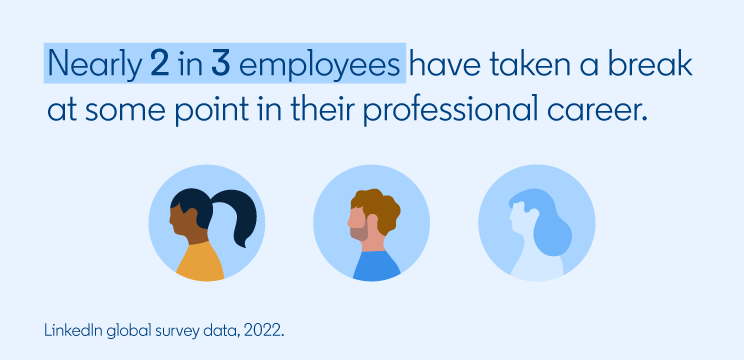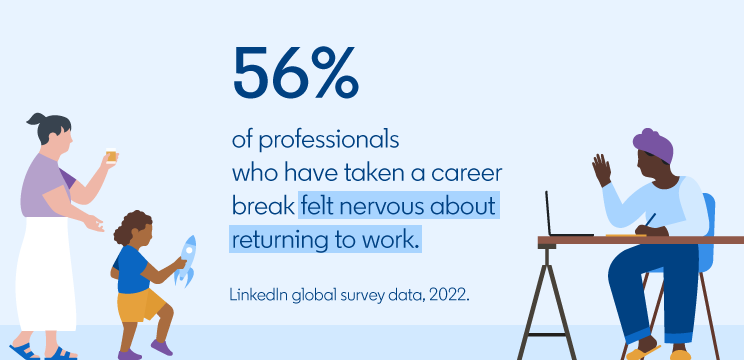
How to Support Employees Returning to Your Nonprofit After a Career Break
Nearly two-thirds (62%) of employees have taken a break at some point in their professional career, according to a LinkedIn survey of nearly 23,000 workers and over 7,000 hiring managers. Another 35% of respondents say they hope to take a career break at some point in the future.
Yet despite how common career breaks have become, a majority of employees still sense a stigma around them. Over half (56%) of surveyed professionals who have taken acareer break admit they felt “nervous” about returning to work.
There are countless reasons why employees of all genders may want or need to take a career break, from parental and caregiving obligations to health issues, layoffs, and career transitions. Making the effort to destigmatize career breaks and support returning employees benefits everyone — and it can start at your nonprofit.
By following these steps to help employees successfully return from an extended break, you can prevent burnout, empower returning team members to do their best work, and prove that your organization is an exceptional place to work.

Create a plan for the career break and return
Supporting an employee through a career break starts before the break begins. While it’s not always possible to plan a career break far in advance, ideally, it’s best to co-create a plan ahead of time, or at least before the employee comes back. This will help ensure that they — and the rest of the team — know what to expect.
In their LinkedIn Learning course on Planning Your Family Leave and Return, instructors Kelley Biskupiak and Susan Rietano Davey call this a “work coverage plan.” When scheduling time to discuss it, make it clear that you want to have a cooperative, collaborative planning session. Discuss the logistics of managing the employee’s work while they’re gone and what will happen when they return, identifying solutions that work well for both of you. For example, the employee may appreciate the option to work flexible hours or part time as they transition back into the organization after their break.
Most importantly, be open to your employee’s suggestions. The employee may already have an informed idea of how to make their break work. Connect with your HR team and leaders to see what’s possible and aim to shape your plan with everyone’s needs in mind.
Provide resources for getting your employee back up to speed
Before and during your planning meeting, take the time to brainstorm what your employee will realistically need to return to work after a prolonged absence. Then, a few weeks before the employee’s scheduled return date, share a step-by-step reintegration plan.
This could include organizing a buddy system during their first month back, ensuring the employee always has somewhere to turn if they have questions about projects your nonprofit tackled while they were out. Perhaps you could even pair them up with a leader who has previously taken a career break themselves for a few mentorship conversations.
If your organization uses LinkedIn Learning as part of its learning and development (L&D) strategy, your employee may be interested in taking a course like Returning to Work with a Resume Gap as they start to prepare for their return. Depending on how long they’ve been out, they may also find it helpful to explore courses related to their work to refresh their skills and build their confidence about returning.
Letting employees know that they still have access to an on-demand resource like this while they’re out can be a good way to signal to them that you’re truly invested in their professional development — a career break won’t change that.

Welcome your employee back with empathy
Choosing to take a career break can be a difficult but necessary decision, especially for people who feel a deep connection with their work, like nonprofit professionals. That’s why it’s so important for managers to respond with empathy and understanding before, during, and after the break.
According to leadership and development expert Carolyn Goerner in her course Empathy at Work, “Even when we practice empathy with the best of intentions, sometimes it’s hard to take ourselves out of the equation and really focus on the other person’s experience.” Here are a few of the tips that Carolyn recommends in her course that may be helpful for managers looking to be more supportive of career breaks:
- Remove distractions: It’s difficult to practise true empathy when you have other things on your mind. Even though nonprofit work can be demanding, try to create a distraction-free environment to listen to the employee’s thoughts and concerns. This might involve blocking time on your calendar, having a closed-door meeting, and silencing your phone.
- Take judgement out of the equation: Every employee is different and their emotional responses to challenges like returning from a career break will differ. There is no wrong way to feel.
- Avoid the urge to immediately problem-solve: Jumping to offer suggestions or advice when someone is struggling might seem helpful on the surface, but the employee may need time to process their emotions first. Listen and seek to understand before making any suggestions.
Even if their team was supportive of their career break, employees may be worried about how they’ll be received when they return. You can help alleviate this anxiety by welcoming them back enthusiastically. Make sure their first week includes opportunities to reconnect with their managers and team members, and let them know that they were missed, without suggesting that their absense was a burden.
This will not only help the returning team member feel welcome, but can also give other employees confidence that your nonprofit cares about its people.

Being supportive of career breaks can support long-term retention
Helping an employee return from a career break is an investment in your nonprofit’s future. Professionals do their best work and want to stay at their organizations when they feel appreciated and supported. In fact, 53% of people say they are better at their job after having a career break.
By destigmatizing career breaks and creating the right environment for returning employees, you can avoid top performers from leaving and build a happy, productive, and loyal nonprofit workforce in the long run.
Want to provide all employees with a resource to support their professional growth and development — while keeping your organization’s skill base up to date? Discover what LinkedIn Learning can do for your nonprofit.

